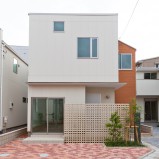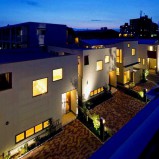東日本大震災直後の2011年に計画がスタートした、伝統工法に拠る14棟の木造建売分譲住宅群。東京の北部に計画されたこの住宅群は、東京では珍しく、起伏のある美しい森や公園が点在する板橋区景観最重点地域内にあり、南面傾斜に計画された絶好のロケーションである一方、敷地面積85sqmいわゆる「狭小」住宅の集落を形成している。この計画は、震災直後からスタートした事もあり、地震や火災に対する安全性を確保しながら、震災で傷ついた心を繋なぐ架け橋としての環境デザインを追求している。
私たち日本人が震災を経験して感じた「人と人との繋がり・心の絆の大切さ」を分かち合う為には「自分の住む界隈を大切に思う気持ちの醸成」と「心に残る美しいデザイン」が必要だと結論づけた。そこで周辺環境との共生を考え、住民の方達が自発的に手入れできる最新の緑化施策(周辺に棲息する植物をベースにした緑化を敷地内へも実施、雨水や住民による打ち水で夏場の路面温度を抑制し周辺との温度差で風を誘引する保水ブロックを域内道路に敷設、環境配慮型の植生ブロックを導入実施など)を取っている。
単に環境を延命させる事のみならず、住民同士のメンテナンスを通じたコミュニケーションの活性化を狙ったものである。日本人は、元来自分の住む環境を手入れすることで高い倫理観を形成してきた。この住宅群は、現在を生きる私たち日本人が忘れてしまった「手入れ」を呼び起こす為に、緑を通じてここに住む人たちの価値感を受け入れながら、建物や自分たちの住む界隈を大切に思う気持ちや記憶としての情景が芽生えるように企てている。
Ready-built houses in northern Tokyo, starting right after Great Quake in 2011, pursue environmental design to re-connect suffered hearts.
14 wings of ready-built houses of traditional construction method for sale. The project started in 2011, just after the Great East Japan Earthquake. Located in the north of Tokyo, the site is in the area designated for landscape protection. The area has a beautiful hilly forest and parks. The site is, therefore, in the best location for a housing project, while each plot is narrow and small of only 85 sqm. The project, starting right after the earthquake, pursues the environmental design to re-connect the suffered hearts with the safety against an earthquake and fire.
We concluded that “fostering attachment to local area” and “memorable and beautiful design” are necessary to share “connections between people and importance of bonds,” which we Japanese realized through the earthquake. We installed cutting-edge planting methods, which residents can take care of on their own, in harmony with surrounding flora and fauna. These methods include plantings based on the surrounding flora even in each plot, streets with water retention pavements to induce wind due to the difference of temperatures by residents’ sprinkling water in summer, and environmentally-friendly planting blocks.
These would, not just respect the surrounding natural environment, activate communication among residents. Japanese, in nature, have formed high level of ethics by taking care of the surrounding environments. The houses aim to evoke residents of such actions of “taking care,” which current Japanese are not aware of. The houses, with plantings as a key factor, will absorb the residents” sense of values and the landscape will witness local-attachment and memorable scenes.
























